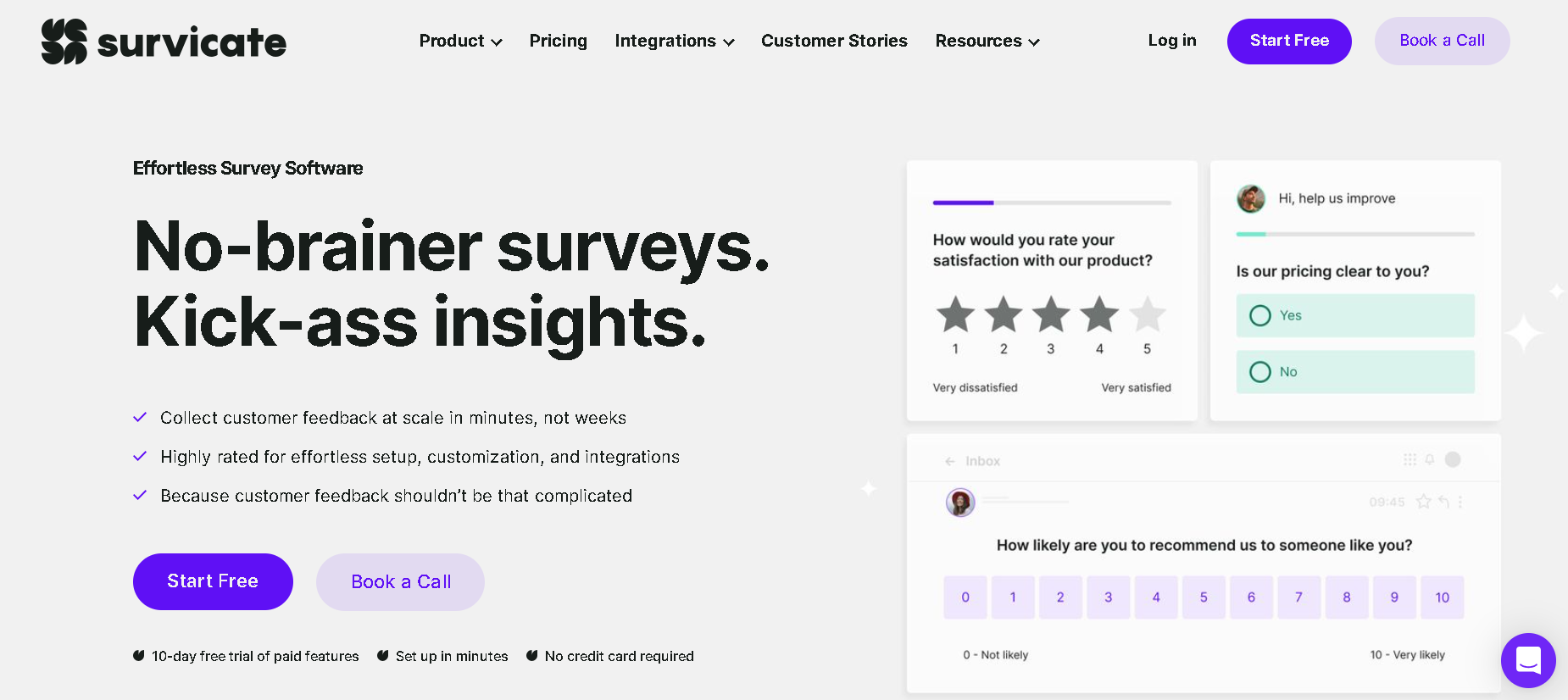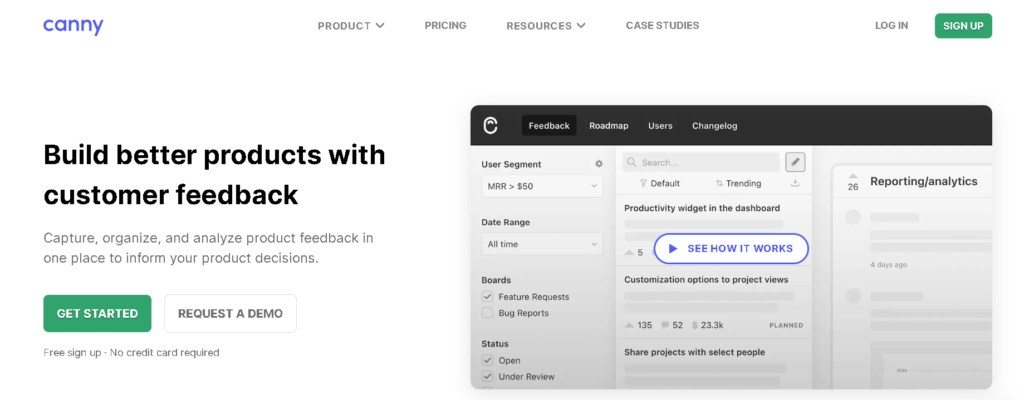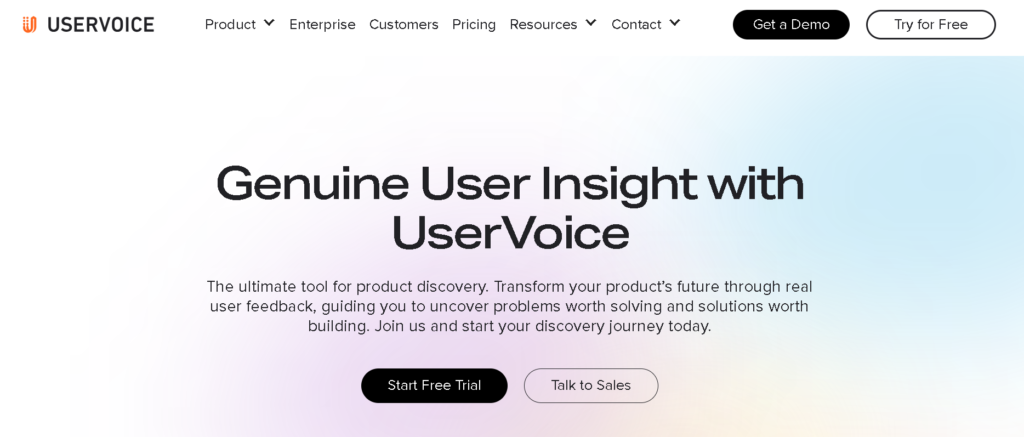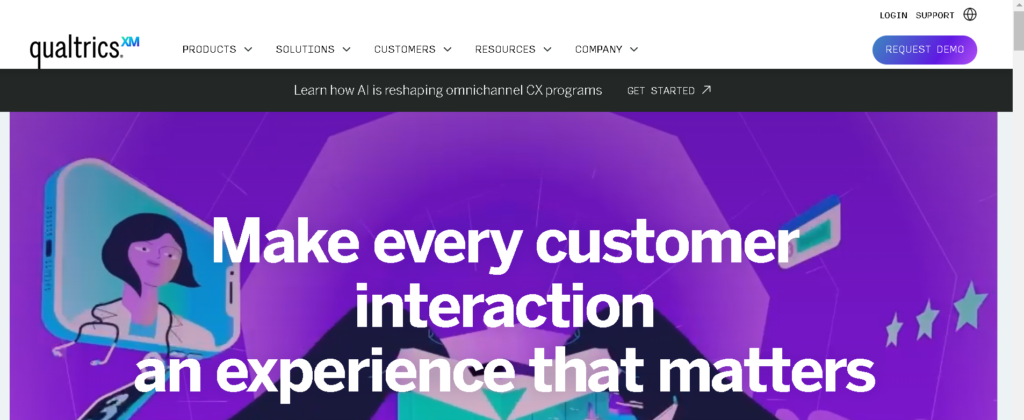What is Customer Feedback Management?
Customer Feedback Management (CFM) is a vital cog in the machinery of modern business. It's not just about collecting opinions; it's about understanding, analyzing, and acting on those insights to drive growth and satisfaction.
In a world where only 1 in 26 customers voice their complaints (as noted by CXM) and the rest silently drift away, CFM becomes a beacon guiding businesses towards success. It's a dynamic process that involves:
a) Listening Actively
Whether it's through surveys that must grab attention in just 8 seconds (Digital Information World) or social media, where 47% of complaints are voiced (Sprout Social), CFM is about tuning in.
b) Analyzing Intelligently
With 83% of consumers completing at least one survey form annually (Market Force), the data is rich. But it's not just about quantity. It's about using the latest data integration software to gain quality insights that lead to action.
c) Responding Effectively
58% of people will never use a company again after one bad experience (NewVoiceMedia). CFM is about turning feedback into positive change, especially if it means 86% of customers are willing to pay up to 25% more for a better experience (RightNow Technologies).
The multifaceted world of customer feedback management involves diving into its importance, best practices, tools, and the latest statistics that shape this essential business function. Whether you're a seasoned professional or just starting, these insights will empower you to connect with your customers like never before.
Understanding Customer Feedback Management
Customer Feedback Management (CFM) is more than a buzzword. It's a systematic approach that encompasses several key components:
a) Collection
Gathering feedback through various channels, including surveys, social media, and direct interactions. It's about asking the right questions at the right time, considering that attention can be lost in just 8 seconds (Digital Information World).
b) Analysis
Sifting through the data to identify trends, patterns, and actionable insights. With tools like SurveyMonkey, businesses can avoid the pitfalls of long surveys that lead to inaccurate answers.
c) Action
Implementing changes based on feedback, whether it's improving a product or enhancing customer service. Customer feedback should be built into your roadmap planner to continuously improve your product. Additionally, consider using customer service software to efficiently manage and respond to feedback.
Customer Feedback Management Metrics
Customer Feedback Management (CFM) metrics are essential tools that help businesses gauge customer satisfaction, loyalty, and overall experience. Here's an explanation of some key CFM metrics and a use case for each:
1. Net Promoter Score (NPS)
The NPS process is crucial as it measures customer loyalty by asking how likely customers are to recommend a product or service to others. Scores range from -100 to +100, with higher scores indicating greater loyalty.
Use Case:
A fintech app development company wants to understand customer loyalty after releasing a new update. By using NPS, they find that the score has increased by 10 points, indicating improved customer satisfaction with the new features.
2. Customer Satisfaction Score (CSAT)
CSAT measures customer satisfaction with a specific interaction or transaction. It's usually measured on a scale of 1 to 5 or 1 to 7.
Use Case:
A restaurant chain uses CSAT to gauge customer satisfaction with their dining experience. Low CSAT scores in certain locations lead to targeted training for staff, improving service quality.
3. Customer Effort Score (CES)
CES assesses how easy it is for customers to get their issues resolved or achieve their goals with a product or service.
Use Case:
An e-commerce platform uses CES to measure the ease of the checkout process. High effort scores lead to a redesign of the checkout flow, making it more user-friendly.
4. Churn Rate
Churn rate calculates the percentage of customers who stop using a product or service during a specific time period. Understanding customer churn is crucial for SaaS businesses, as reducing it can improve retention and drive long-term growth
Use Case:
A subscription-based fitness app tracks churn rate to identify when and why users are canceling. A spike in churn rate after a price increase leads to a reevaluation of pricing strategy.
5. Retention Rate
Retention rate measures the percentage of customers a company retains over a specific period.
Use Case:
A SaaS company tracks retention rates to understand long-term customer engagement. A steady increase in retention rates correlates with ongoing improvements to the platform, validating the development strategy.
6. Lifetime Value (LTV)
LTV calculates the total revenue a company expects to earn from a customer throughout their entire relationship.
Use Case:
A retail brand uses LTV to segment customers and tailor marketing strategies. High LTV customers receive exclusive offers, enhancing brand loyalty and encouraging repeat purchases.
7. Voice of the Customer (VOC) Program Metrics
VOC metrics encompass various data points that capture customer feedback, preferences and expectations.
Use Case:
A hotel chain implements a VOC program to gather feedback across all touchpoints. Analysis of VOC data leads to personalized guest experiences, increasing repeat bookings.
Gathering, Analyzing and Taking Action on Feedback
The CFM process is a continuous cycle that involves:
1. Gathering Feedback: Utilizing tools like email surveys with a response rate of 24.8% (FluidSurveys) or SMS text code with a 40% response rate
2.Analyzing Feedback: Understanding customer emotions and sentiments, identifying feedback trends, and creating actionable insights.
3. Taking Action: Prioritizing and implementing changes, following up with customers, and tracking progress.
Importance in Guiding Product Development and Improving Customer Experience
CFM plays a crucial role in various aspects of business:
a) Product Development
Feedback guides innovation, ensuring that products meet and exceed customer needs and expectations. Young shoppers, typically aged 18-24,expect at least 200 product reviews (Outcry).
b) Customer Experience
82% of consumers have taken their business elsewhere due to poor service (NewVoiceMedia). CFM helps in identifying areas for improvement, enhancing satisfaction, and building loyalty, which is why some companies choose to outsource customer support to specialized partners.
c) Business Growth
Online reviews are vital for local search engine rankings (Local SEO Guide) and 66% of customers trust a brand with many reviews (Outcry). CFM helps in expanding its online presence and attracting new customers. Michal Kierul , CEO of InTechHouse , encapsulates the essence of CFM, stating:
"Customer Feedback Management is not just a tool; it's the heartbeat of our business. It informs our product strategy, shapes our customer interactions and fuels our growth. In a world where customer needs are ever-changing, CFM is our compass, guiding us to innovate adapt and excel."
Why is Customer Feedback Management Important?
In today's competitive business landscape, understanding and responding to customer needs is not just a strategic advantage; it's a necessity. Customer Feedback Management (CFM) emerges as a critical tool in this context, bridging the gap between customer expectations and business offerings.
But why is CFM so essential?
Why does it hold such a pivotal place in modern business operations? Whether you're a startup or an established enterprise, CFM is the key to unlocking customer satisfaction and business success. Let's explore why!
A) Aligning Business Decisions and User Experience
a) Understanding Needs: CFM uncovers customer preferences, guiding businesses in creating resonant products and services.
b) Guiding Development: Businesses use CFM to align with customer feedback, ensuring products meet market demands.
c) Enhancing Experience: Through CFM, businesses place the customer journey at the forefront, leading to satisfaction and loyalty.
B) Building Trust, Loyalty, and Retention
a) Trust Building: Online reviews and social media engagement through CFM build trust and credibility.
b) Loyalty Cultivation: Businesses foster loyalty and long-term relationships by actively listening and responding to feedback.
c) Retention Strategy: By identifying and addressing issues promptly, CFM prevents customer attrition.
C) Damage Control and Actionable Insights
a) Complaint Handling: Businesses use CFM to handle complaints effectively, turning negative feedback into opportunities for improvement.
b) Social Media Engagement: CFM ensures businesses hear and address customer voices on social media platforms.
c) Mobile Reach: Businesses must make CFM strategies mobile-friendly to connect with a broader audience.
Best Practices in Customer Feedback Management
Effective Customer Feedback Management (CFM) is a nuanced process that requires careful planning, execution, and continuous improvement. Here's how to make it work:
A) Defining Objectives and Tailoring Processes
1. Identifying Needs and Selecting Appropriate Metrics:
a) Determine the specific goals of your feedback collection.
b) Choose metrics that align with these goals, such as the Net Promoter Score (NPS) for loyalty or the Customer Satisfaction Score (CSAT) for satisfaction.
2. Aligning the Feedback Process with Business Goals:
a) Integrate feedback collection with overall business objectives.
b) Ensure that feedback informs product development, customer service improvements, and marketing strategies.
B) Collecting and Categorizing Feedback
1. Utilizing Various Channels for Surveys:
a) Employ email, social media, in-app surveys, and face-to-face interviews to reach different customer segments.
b) Test and optimize channels for response rates and quality.
2. Dividing Feedback into Support, Product, Technical, and Feature Issues:
a) Create clear categories for feedback to streamline analysis.
b) Assign specific teams or individuals to handle different categories, ensuring expertise in addressing issues.
C) Analyzing Customer Feedback
1. Identifying Trends and Creating Dashboards:
a) Use analytics tools to visualize feedback trends over time.
b) Create dashboards that key stakeholders can access, fostering a data-driven culture.
2. Measuring Sentiment and Emotions:
a) Apply sentiment analysis to understand the underlying emotions in feedback.
b) Use these insights to tailor communication and address underlying concerns.
D) Taking Action and Tracking Progress
1. Prioritizing and Implementing Insights:
a) Develop a priority system based on feedback's potential impact and alignment with business goals.
b) Create action plans and use task management tools to assign responsibilities for implementation.
2. Following Up with Customers and Optimizing Feedback Loop:
a) Inform customers about the actions taken based on their feedback.
b) Continuously monitor and optimize the feedback process, seeking ways to increase efficiency and effectiveness.
E) Using Feedback for Internal Brainstorming and VOC Program
1. Developing a Customer-Centric Culture:
a) Encourage teams to use customer feedback in brainstorming sessions.
b) Reward and recognize employees who actively engage with customer feedback.
2. Establishing a Formal Voice of the Customer (VOC) Program:
a) Design a structured VOC program that includes regular feedback collection, analysis, and action.
b) Involve cross-functional teams to ensure that the VOC program influences all aspects of the business.
Customer Feedback Management Tools
There are numerous tools to help with customer feedback management. Here are six of them:
1. Survicate
Survicate is a customer feedback survey tool designed to provide effortless insights at scale. It offers a range of features that make survey creation, distribution, and analysis a seamless process.
Pricing
Survicate offers a free plan with no time limit, allowing businesses to set up and start collecting feedback without any initial investment. For more advanced features and integrations, you may need to explore their paid plans, details of which can be found on their pricing page.
Who is it for?
1. Effortless Survey Creation: Survicate is ideal for businesses looking to create and automate surveys without coding. The intuitive drag-and-drop creator makes it accessible for users of all skill levels.
2. Multi-Channel Feedback Collection: With the ability to run surveys in-product, on websites, through email, links and mobile apps. Survicate is suitable for businesses seeking to reach customers across various touchpoints.
3. Integration with Popular Tools: Survicate offers 1-click native integrations with tools like Hubspot surveys, Salesforce, Slack and more, making it a perfect fit for businesses that want to enrich their data with customer feedback.
4. High Response Rates: With an average online survey response rate of ~30%, Survicate is a great choice for companies aiming to capture more insights, even from partially completed surveys.
5. User Research at Scale: Companies looking to understand survey responses at a glance and act on feedback will find Survicate's features like NPS, CSAT, and text matrix selection valuable.
In essence, Survicate is a versatile customer feedback management tool that caters to businesses aiming to tap into customer insights effortlessly. Whether it's a startup looking to understand user behavior or an established enterprise aiming to integrate feedback into their existing tools, Survicate offers a scalable solution.
2. SurveyMonkey
SurveyMonkey is one of the world's leading online survey tools, designed to facilitate the creation, distribution, and analysis of surveys. It offers a comprehensive suite of features that cater to various survey needs.
Pricing
SurveyMonkey operates using a freemium model, in which they let you test limited features before signing up for a plan. Pricing starts at $39 per month.
Who is it for?
1. Versatile Survey Creation: SurveyMonkey is suitable for individuals and businesses that want to build and customize high-quality surveys and forms.
2. Broad Data Collection: With the ability to collect information and feedback from almost anywhere, SurveyMonkey is ideal for researchers, marketers, and organizations looking to gather insights from diverse sources.
Apart from that, gathering data via different websites using website unblocker tools can further enhance the breadth and depth of the insights collected.
3. Integration with Various Platforms: SurveyMonkey's compatibility with different platforms makes it a go-to tool for businesses aiming to integrate survey data with other systems.
4. Academic and Market Research: Educational institutions and market research firms can leverage SurveyMonkey's robust features to conduct in-depth studies and analyses.
5. Employee and Customer Feedback: Companies seeking to understand employee satisfaction or customer preferences will find SurveyMonkey's tailored templates and analytics valuable.
In summary, SurveyMonkey is a comprehensive tool that caters to a wide range of survey needs. Whether it's a small business looking to understand customer preferences or a large corporation aiming to gather employee feedback, SurveyMonkey offers flexible and scalable solutions.
3. Canny
Canny is a customer feedback management software designed to help businesses build better products by capturing, organizing, and analyzing customer feedback.
Pricing
Canny has a free plan that lets you test some of the features. It starts at $360 per month.
Who is it for? (Ideal Use Case)
1. Capture Product Feedback: Canny is designed for businesses that want to collect all feedback in one place, ensuring that no valuable insights slip through the cracks.
2. Inform Product Decisions: If you're looking to analyze feedback to see what's most impactful and avoid building the wrong things, Canny offers features to uncover valuable customer insights.
3. Prioritize and Roadmap: Canny helps in ranking features by priority and building a product roadmap, integrating with project management tools like Jira, ClickUp and Asana.
4. Engage with Product Updates: For businesses aiming to keep the feedback loop strong and boost customer engagement and retention, Canny automatically follows up with people when releasing a feature.
5. Integration with Existing Workflow: Canny integrates with tools already used for customer service and project payroll management, making it suitable for businesses looking for a seamless workflow.
In summary, Canny is a comprehensive tool for businesses aiming to make better product decisions through customer feedback. Whether you're looking to capture feedback, analyze it, prioritize features, or engage customers with updates, Canny offers a dedicated platform to deliver a better customer experience.
4. UserVoice
UserVoice is a product feedback management and roadmap software that aims to transform user feedback into actionable insights. It focuses on continuous product discovery, prioritizing opportunities and boosting customer engagement.
Pricing
Starts from $699 per month.
Who is it for?
1. Product Discovery Teams: UserVoice is designed to help teams embrace continuous product discovery, transforming user feedback into insights that shape product evolution.
2. Customer Engagement Focus: If you want to ensure that customer feedback doesn’t go into a black hole, UserVoice offers real-time, scalable tools to address and respond to feedback.
3. Data-Driven Decision Making: UserVoice provides valuable data-driven insights, empowering product decisions and fostering a user-centric development approach.
4. Integration with Existing Tech Stack: With out-of-the-box integrations, UserVoice can easily connect to your existing technology stack.
5. Scaling Feedback Management: From centralizing feedback to engaging customers with status updates, UserVoice offers solutions for every stage of growth, making it suitable for startups to enterprises.
UserVoice is a powerful tool for businesses looking to leverage customer feedback to drive product strategy, innovation and customer engagement. With a range of pricing plans and features it offers a scalable solution for companies of all sizes.
5. Qualaroo
Qualaroo is a customer and user feedback software designed to provide valuable insights through contextual surveys. It offers a range of features to capture user feedback in real-time, target users with specific questions and analyze responses through AI-powered analytics.
Pricing
You can try all the features for free for 15 days. Starts from $69 per month.
Who is it for?
1. Optimizing Web &App Experience: Qualaroo is suitable for businesses looking to understand user thoughts about their website or app while they are using it. It helps in gathering product feedback and boosting conversion rates.
2. Advanced Targeting for Insights: With Qualaroo, you can target specific users for actionable feedback based on various criteria such as location, behavior, and engagement.
3. User Experience Insights: Qualaroo offers delightful templates and branding options to gather feedback on design, functionality, and user experience without being intrusive.
4. AI-Powered Analytics &Reports: Powered by IBM WATSON, Qualaroo provides sentiment analysis and advanced reporting to turn free-form text into organized data, making it suitable for businesses looking for comprehensive user feedback insights.
5. Integration with Popular Tools: Qualaroo integrates with platforms like Zapier, Google Analytics, Slack, Salesforce, and more, making it ideal for businesses that want to merge qualitative insights with quantitative data.
6. Prototype Testing: Qualaroo is also useful for capturing user feedback quickly and painlessly at every stage of the design process, including prototype testing.
In summary, Qualaroo is a versatile tool that caters to businesses aiming to capture real-time user feedback and turn it into actionable insights. Whether it's a website looking to optimize user experience or a product team seeking to understand customer preferences, Qualaroo offers a robust solution.
6. Qualtrics
Qualtrics is a leading Experience Management (XM) software that offers three suites to create exceptional customer frontlines, high-performing teams, and products people love. It provides tools to understand what people need and deliver it every time, making every interaction an experience that matters.
Pricing
Qualtrics does not provide specific pricing details on its main page. However, you can explore their various offerings and request a personalized demo to understand the pricing structure that best fits your needs.
Who is it for?
1. Customer Frontline Management: Qualtrics is designed for businesses aiming to deliver better experiences across digital and physical touchpoints, including contact centers, digital platforms, and physical locations.
2. People Teams and HR Management: With tools to engage teams, improve manager effectiveness, and make informed business decisions, Qualtrics is suitable for HR professionals and organizational development.
3. Strategy &Research Teams: Qualtrics offers software to design products that people love, increase market share, and accelerate growth. It's ideal for product managers, market researchers, and strategic planners.
4. Healthcare Experience Management: Qualtrics provides resources to understand healthcare experience trends, making it suitable for healthcare providers and administrators.
5. Integration with Existing Feedback Management System: With the ability to integrate with various platforms. Qualtrics is suitable for businesses looking to blend experience data with operational data for comprehensive insights.
Qualtrics is a versatile XM platform that caters to a wide range of business needs from customer experience management to employee engagement and product strategy. Whether you're a small business aiming to understand customer needs or a large corporation looking to align experience management across the organization, Qualtrics offers a robust solution.
Conclusion
Customer Feedback Management (CFM) is a vital aspect of modern business operations. It encompasses the collection, analysis, and utilization of customer feedback to enhance products, services, and overall customer experience.
Try to invest in tools like a business VoIP number that can help you to elevate your overall customer experience.
By employing the right tools, strategies, and metrics, businesses can create a customer-centric culture that fosters growth and innovation. From defining clear objectives to utilizing advanced tools like Survicate, SurveyMonkey ,Canny ,UserVoice ,Qualaroo and Qualtrics , CFM offers a pathway to understand customer needs and deliver exceptional experiences.
FAQ's
Q. What CRM tools are used for customer feedback?
Customer Relationship Management (CRM) tools are used to manage interactions with customers and potential customers. For customer feedback, CRM tools like Salesforce, HubSpot and Zoho can be integrated with feedback management platforms to collect, analyze and act on customer feedback. These integrations allow businesses to align customer feedback with sales, marketing and support efforts creating a cohesive customer experience strategy.
Q. How do you handle customer feedback?
Handling customer feedback involves several key steps:
1. Collecting Customer Feedback: Utilize various channels like surveys, social media, and direct communication to gather feedback.
2. Categorizing Feedback: Divide feedback into different categories such as product, support, technical, and feature issues.
3. Analyzing Feedback: Use tools and analytics to identify trends, sentiments, and actionable insights.
4. Taking Action: Prioritize and implement changes based on feedback, ensuring alignment with business goals.
5. Communicating with Customers: Follow up with customers to inform them of actions taken and maintain an open customer feedback loop.
6. Monitoring and Adjusting: Continuously monitor feedback and make necessary adjustments to processes and products.
Q. How do you process customer feedback data?
Processing customer feedback data involves:
1. Aggregation: Collect customer feedback from various sources into a centralized system.
2. Segmentation: Divide feedback into relevant categories and segments for targeted analysis.
3. Analysis: Utilize analytics tools to identify patterns, sentiments, and key insights. AI-powered analytics can provide deeper understanding.
4. Visualization: Create dashboards and reports to visualize feedback data, making it accessible for decision-makers.
5. Integration: Integrate feedback data with other business systems like CRM, marketing, and product development to align strategies.
6. Action Planning: Develop action plans based on insights, prioritizing initiatives that align with business objectives.
7. Tracking and Optimization: Implement changes and track progress, continuously optimizing the feedback management process.













